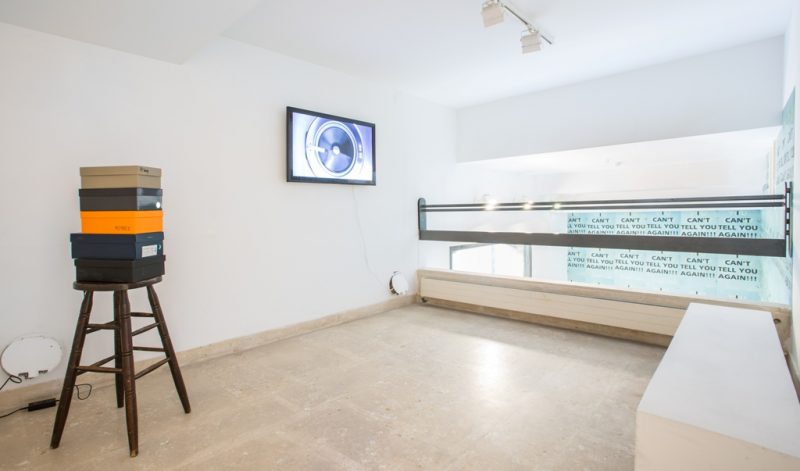28.9 — 31.1 18
-

-
 Giles Round, You know the old story... I can't tell you again!!!, 2015
Giles Round, You know the old story... I can't tell you again!!!, 2015
-
 Giles Round, You know the old story... I can't tell you again!!!, 2015
Giles Round, You know the old story... I can't tell you again!!!, 2015
-
 Giles Round, Summers in Itay, Winters in New York, 2017
Giles Round, Summers in Itay, Winters in New York, 2017
-
 Groundfloor
Groundfloor
-
 Benjamin Hirte, Vector (Marlboro theme), detail, 2016
Benjamin Hirte, Vector (Marlboro theme), detail, 2016
-
 Vanessa Safavi, The witness, 2017
Vanessa Safavi, The witness, 2017
-
 Benjamin Hirte, ̴ , 2013
Benjamin Hirte, ̴ , 2013
-
 Giles Round, They parted at the end of spring. He couldn't promise anything, 2017
Giles Round, They parted at the end of spring. He couldn't promise anything, 2017
-
 First Floor
First Floor
-
 Walter Martin & Paloma Munoz, My Way, 2017
Walter Martin & Paloma Munoz, My Way, 2017
-
 Daniel Faust, Faust 2010-17, 2017
Daniel Faust, Faust 2010-17, 2017
-
 Aki Sasamoto, Shoelight box 2016 and Birds, Dung Beetles, the Washer, 2016 (video)
Aki Sasamoto, Shoelight box 2016 and Birds, Dung Beetles, the Washer, 2016 (video)
-
 Aki Sasamoto, Shoelight box 2016
Aki Sasamoto, Shoelight box 2016
-
 The Curatorial Collective
The Curatorial Collective
28.9 — 31.1 18
In a society that is constantly looking for
more, we often find ourselves thinking, how
much is too much?
The School for Curatorial Studies Venice presents “How Much Is Too Much?” opening on 28 September at 18.00 in A Plus A Gallery.
Curated by 21 international students from The School for Curatorial Studies Venice, including works by:
Amelia Crouch (UK) | Oliver Czarnetta (GER) | Sam Ekwurtzel (USA) | Daniel Faust (USA) | Benjamin Hirte (AT) | Paloma Muñoz & Walter Martin (USA) | Giles Round (UK) | Vanessa Safavi (CH) | Aki Sasamoto (JAP)
In Invisible Cities, Italo Calvino describes the “continuous city” of Leonia, where “every morning the people wake between fresh sheets, wash with just-unwrapped cakes of soap, wear brand-new clothing, and listen to the last-minute jingles from the most up-to-date radio.” Though 45 years have passed, Leonia evokes a familiar image for us today. Global cities are overwhelmed with the seemingly endless amount of things to do and see, not to mention products to consume. With this ambush of physical and emotional stimuli, we cannot help but wonder how contemporary society is able to sift through it all. How do we filter through abundance and store our selections? In a society constantly looking for more, we often find ourselves thinking, How Much is Too Much?
Confronted with excess, our instinctive reaction is to organize and compartmentalize our thoughts and experiences. On the one hand, this can serve as an effective coping mechanism to deal with topics we are not ready to address. On the other, it can function as a form of denial or stigmatization. We accumulate and expel, putting things aside to deal with them later, but more often than not we forget what we have put away in the first place. What do our discarded experiences, interactions, thoughts, and objects say about us? How does compartmentalizing as an attempt to manage excess affect our psyche, perception, and overall society? Are we missing something when we try to organize, classify, and fit everything into certain structures?
Addressing the urgency in these questions, How Much is Too Much? welcomes visitors on an immersive journey to discover the substance of our sensory archives only to pause and reflect upon the impact of our habits of compartmentalization.
Following A Plus A Gallery’s long history of collective curatorial projects, How Much is Too Much? aims to create an environment of critical reflection for both artist and viewer alike. The exhibition takes the overwhelming excess of contemporary society as its starting point, opening with Giles Round’s playful pieces that encroach upon the very walls they inhabit and thus reference the sensory overload and high-speed dissemination of popular culture, Benjamin Hirte’s minimal reflections on how our behavior is organized by commercial branding and familiar visual cues, and Vanessa Safavi’s more subdued explorations of interiority and all that is hidden. Teased with these expressions of excess and internality, viewers will then make their way to a unique compartmentalized display of works by Amelia Crouch, Oliver Czarnetta, Sam Ekwurtzel, Daniel Faust, Paloma Muñoz & Walter Martin and consequences of how we deal with the muchness around us. Bringing these artists together using experimental modes of display, How Much is Too Much? presents a wide range of new and existing works to shed light on an increasingly pressing issue of our time. Instead of allowing our compartments to pile up and push further out, teetering on the edge of a landslide, let us examine the contents of what we have sealed away.
Major support for the exhibition is provided by RAJAPACK and our long time partners We Exhibit and Drusian.
For more information and press material:
Giulia Artico – Ufficio Stampa
Cell: 3489335693
A plus A gallery
The School for Curatorial Studies Venice
San Marco 3073
Venezia 30124
[email protected]
[email protected]
Tel. 041 2770466